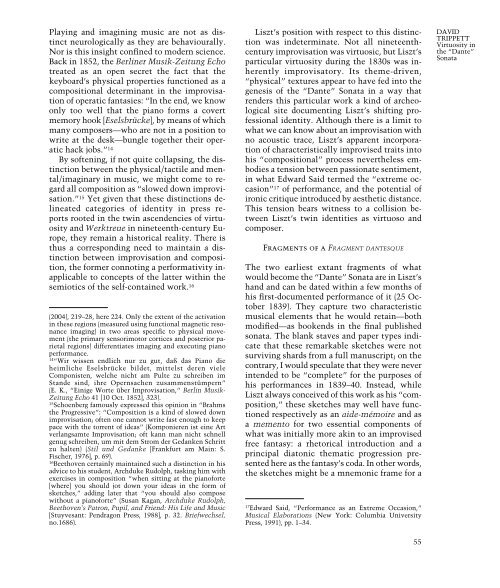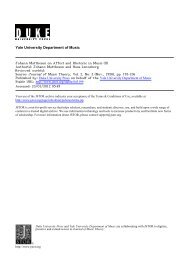19THCENTURYMUSICroad to Weimar amid the “most intense periodof anti-virtuosity backlash in the history ofinstrumental music,” 7 which in turn gave riseto a “strengthening forcefield between virtuosity<strong>and</strong> the work.” 8 If <strong>Liszt</strong> compared thevirtuoso’s career with a caterpillar’s confinement,did this disqualify “virtuosity” per se orwas it merely a response to public criticism?The comparison prompts another question thatcritics of many stripes have asked of authorshipwithin text- <strong>and</strong> score-based criticism:Who is speaking? 9 <strong>Liszt</strong>’s liquidation of hisperformer’s “self” testifies to his <strong>de</strong>sire to managehis public i<strong>de</strong>ntity strategically, to narratehis own story in a self-styled Künstlerroman,<strong>and</strong> thus to both publicize <strong>and</strong> legitimize hisnew i<strong>de</strong>ntity as a composer <strong>and</strong> ex-virtuoso. 10But as he entered into the service of a patronfor the first time in his professional career—not exactly the unfettered freedom of a butterfly—didthis transformation <strong>une</strong>quivocally representa <strong>de</strong>dicated commitment to a new causeor did it arise, at least in part, from his anxietyover the diminishing status of the virtuoso?In this article I would like to consi<strong>de</strong>r thesequestions in light of <strong>Liszt</strong>’s <strong>Après</strong> <strong>une</strong> lecturedu Dante: Fantasie quasi Sonata. Written between1839 <strong>and</strong> 1858, the Sonata survives inthree full manuscripts <strong>and</strong> four fragments <strong>and</strong>,I contend, interweaves hours <strong>and</strong> hours of improvisationwith a gradual process of revisionon a more abstracted, conceptual level. As apiece born expressly from acts of performance,the Sonata appears not to be regulated exclusivelyby the i<strong>de</strong>a that a work is an enduring,7Dana Gooley, The Virtuoso <strong>Liszt</strong> (Cambridge: CambridgeUniversity Press, 2004), p. 13. As Gooley observes, an antivirtuosostance was propoun<strong>de</strong>d by both Schumann’s NeueZeitschrift <strong>and</strong> Schlesinger’s Revue et Gazette musicale.8Jim Samson, <strong>Virtuosity</strong> <strong>and</strong> the Musical Work (Cambridge:Cambridge University Press, 2003), p. 74.9To cite two notable examples: Edward T. Cone, TheComposer’s Voice (Berkeley: University of California Press,1974), p. 1; Rol<strong>and</strong> Barthes, “The Death of the Author,” inImage—Music—Text, trans. Stephen Heath (Glasgow:Fontana/Collins, 1977), pp. 142–49.10Within the European press, <strong>Liszt</strong>’s compound nationalities,mobile class status, <strong>and</strong> musical competencies wereall <strong>de</strong>bated among writers <strong>and</strong> listeners as part of whatincreasingly became an unstable <strong>and</strong> over-<strong>de</strong>termined publici<strong>de</strong>ntity. See Gooley’s discussion of the multiple symbolici<strong>de</strong>ntities that <strong>Liszt</strong> fulfilled for his audiences in TheVirtuoso <strong>Liszt</strong>, pp. 2ff.immutable product. It thus subverts what CarolynAbbate calls the “performance network” inwhich performers more or less obey the centripetalforce of a “composed” work. 11 <strong>Liszt</strong>’spredisposition toward virtuosity ensured thatcertain musical i<strong>de</strong>as came to him through improvisationrather than prior to it. At first blushthis seems unsurprising, yet it nevertheless presentsa problem for the i<strong>de</strong>ology of a workconcept that separates <strong>Liszt</strong> hierarchicallyinto pianist <strong>and</strong> composer. In contrast to contemporarieslike Felix Men<strong>de</strong>lssohn or RobertSchumann, <strong>Liszt</strong> in his virtuosity continuallychallenges the aesthetic boundaries of composition,improvisation, <strong>and</strong> performance.Such categories imply a distinction betweenmusical thought in the physical immediacy ofimprovisation <strong>and</strong> musical thought in<strong>de</strong>pen<strong>de</strong>ntof physical enactment (even if the composerworks at the piano). But this distinctionappears increasingly weak in light of <strong>Liszt</strong>ianpractices that seemed to recognize a mutuallyinvertible relation between the fingers’ tactilediscovery of i<strong>de</strong>as at the keyboard <strong>and</strong> the cognitiongoverning those fingers <strong>and</strong> i<strong>de</strong>as. SirJohn Russell even reports that Beethoven continuedto improvise “tactilely” as late as 1821<strong>de</strong>spite being almost totally <strong>de</strong>af, 12 <strong>and</strong> in ourown time, research into brain activity has establisheda substantial anatomical overlap betweenexecuting <strong>and</strong> imaging motor tasks. 1311Carolyn Abbate, In Search of Opera (Princeton: PrincetonUniversity Press, 2001), pp. 9ff.12Russell’s account is reproduced in Oscar G. T. Sonneck,Beethoven: Impressions by His Contemporaries (New York:Dover, 1967), pp. 114–16.13Marc Jeannerod, “Neural Simulation of Action: A UnifyingMechanism for Motor Cognition,” NeuroImage 14(2001), 103–09; Marc Jeannerod, V. Frak, “Mental Imagingof Motor Activity in Humans,” Current Opinion in Neurobiology9 (2001), 735–39; M. Lotze, P. Montoya, M. Erb,E. Hulsmann, H. Flor, U. Klose, N. Birbaumer, W. Grodd,“Activation of Cortical <strong>and</strong> Cerebellar Motor Areas duringExecuted <strong>and</strong> Imagined H<strong>and</strong> Movements: An fMRI Study,”Journal of Cognitive Neuroscience 11 (1999), 491–501. Astudy specific to professional pianists suggests that, exceptin the primary sensorimotor area of the left hemisphere<strong>and</strong> the right cerebellum, playing music in one’shead <strong>and</strong> physically playing at the keyboard activate essentiallythe same cortical regions. There is, in other words,“a subliminal activation of the motor system in motorimagery.” See I. G. Meister, T. Krings, H. Foltys, B.Boroojerdi, M. Müller, R. Töpper, A. Thron, “Piano Playingin the Mind—an fMRI Study on Music Imagery <strong>and</strong>Performance in Pianists,” Cognitive Brain Research 1954
Playing <strong>and</strong> imagining music are not as distinctneurologically as they are behaviourally.Nor is this insight confined to mo<strong>de</strong>rn science.Back in 1852, the Berliner Musik-Zeitung Echotreated as an open secret the fact that thekeyboard’s physical properties functioned as acompositional <strong>de</strong>terminant in the improvisationof operatic fantasies: “In the end, we knowonly too well that the piano forms a covertmemory hook [Eselsbrücke], by means of whichmany composers—who are not in a position towrite at the <strong>de</strong>sk—bungle together their operatichack jobs.” 14By softening, if not quite collapsing, the distinctionbetween the physical/tactile <strong>and</strong> mental/imaginaryin music, we might come to regardall composition as “slowed down improvisation.”15 Yet given that these distinctions <strong>de</strong>lineatedcategories of i<strong>de</strong>ntity in press reportsrooted in the twin ascen<strong>de</strong>ncies of virtuosity<strong>and</strong> Werktreue in nineteenth-century Europe,they remain a historical reality. There isthus a corresponding need to maintain a distinctionbetween improvisation <strong>and</strong> composition,the former connoting a performativity inapplicableto concepts of the latter within thesemiotics of the self-contained work. 16(2004), 219–28, here 224. Only the extent of the activationin these regions (measured using functional magnetic resonanceimaging) in two areas specific to physical movement(the primary sensorimotor cortices <strong>and</strong> posterior parietalregions) differentiates imaging <strong>and</strong> executing pianoperformance.14“Wir wissen endlich nur zu gut, daß das Piano dieheimliche Eselsbrücke bil<strong>de</strong>t, mittelst <strong>de</strong>ren vieleComponisten, welche nicht am Pulte zu schreiben imStan<strong>de</strong> sind, ihre Opernsachen zusammenstümpern”(E. K., “Einige Worte über Improvisation,” Berlin Musik-Zeitung Echo 41 [10 Oct. 1852], 323).15Schoenberg famously expressed this opinion in “Brahmsthe Progressive”: “Composition is a kind of slowed downimprovisation; often one cannot write fast enough to keeppace with the torrent of i<strong>de</strong>as” (Komponieren ist eine Artverlangsamte Improvisation; oft kann man nicht schnellgenug schreiben, um mit <strong>de</strong>m Strom <strong>de</strong>r Gedanken Schrittzu halten) (Stil und Gedanke [Frankfurt am Main: S.Fischer, 1976], p. 69).16Beethoven certainly maintained such a distinction in hisadvice to his stu<strong>de</strong>nt, Archduke Rudolph, tasking him withexercises in composition “when sitting at the pianoforte[where] you should jot down your i<strong>de</strong>as in the form ofsketches,” adding later that “you should also composewithout a pianoforte” (Susan Kagan, Archduke Rudolph,Beethoven’s Patron, Pupil, <strong>and</strong> Friend: His Life <strong>and</strong> Music[Stuyvesant: Pendragon Press, 1988], p. 32. Briefwechsel,no.1686).<strong>Liszt</strong>’s position with respect to this distinctionwas in<strong>de</strong>terminate. Not all nineteenthcenturyimprovisation was virtuosic, but <strong>Liszt</strong>’sparticular virtuosity during the 1830s was inherentlyimprovisatory. Its theme-driven,“physical” textures appear to have fed into thegenesis of the “Dante” Sonata in a way thatren<strong>de</strong>rs this particular work a kind of archeologicalsite documenting <strong>Liszt</strong>’s shifting professionali<strong>de</strong>ntity. Although there is a limit towhat we can know about an improvisation withno acoustic trace, <strong>Liszt</strong>’s apparent incorporationof characteristically improvised traits intohis “compositional” process nevertheless embodiesa tension between passionate sentiment,in what Edward Said termed the “extreme occasion”17 of performance, <strong>and</strong> the potential ofironic critique introduced by aesthetic distance.This tension bears witness to a collision between<strong>Liszt</strong>’s twin i<strong>de</strong>ntities as virtuoso <strong>and</strong>composer.Fragments of a FRAGMENT DANTESQUEThe two earliest extant fragments of whatwould become the “Dante” Sonata are in <strong>Liszt</strong>’sh<strong>and</strong> <strong>and</strong> can be dated within a few months ofhis first-documented performance of it (25 October1839). They capture two characteristicmusical elements that he would retain—bothmodified—as bookends in the final publishedsonata. The blank staves <strong>and</strong> paper types indicatethat these remarkable sketches were notsurviving shards from a full manuscript; on thecontrary, I would speculate that they were neverinten<strong>de</strong>d to be “complete” for the purposes ofhis performances in 1839–40. Instead, while<strong>Liszt</strong> always conceived of this work as his “composition,”these sketches may well have functionedrespectively as an ai<strong>de</strong>-mémoire <strong>and</strong> asa memento for two essential components ofwhat was initially more akin to an improvisedfree fantasy: a rhetorical introduction <strong>and</strong> aprincipal diatonic thematic progression presentedhere as the fantasy’s coda. In other words,the sketches might be a mnemonic frame for a17Edward Said, “Performance as an Extreme Occasion,”Musical Elaborations (New York: Columbia UniversityPress, 1991), pp. 1–34.DAVIDTRIPPETT<strong>Virtuosity</strong> inthe “Dante”Sonata55



